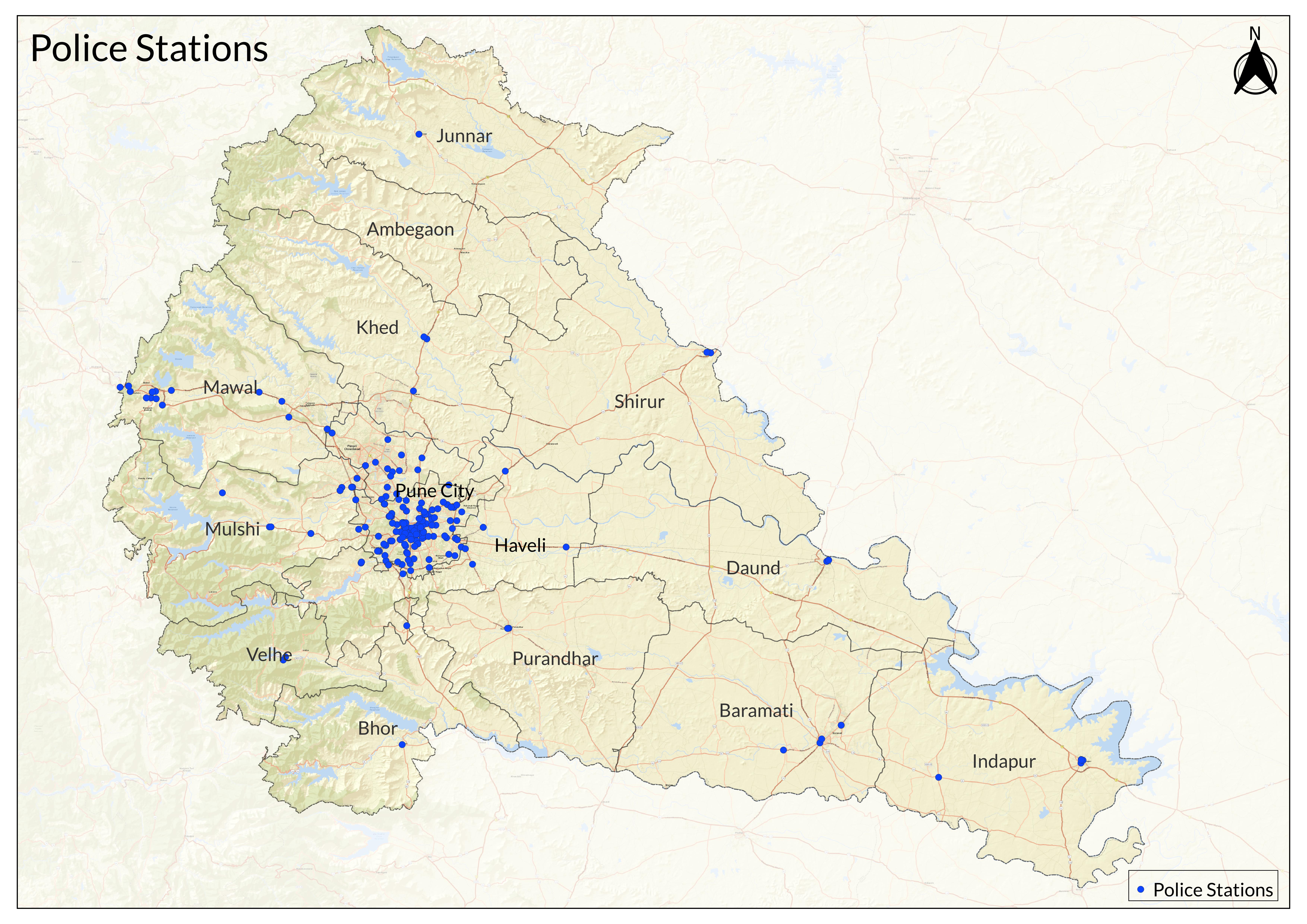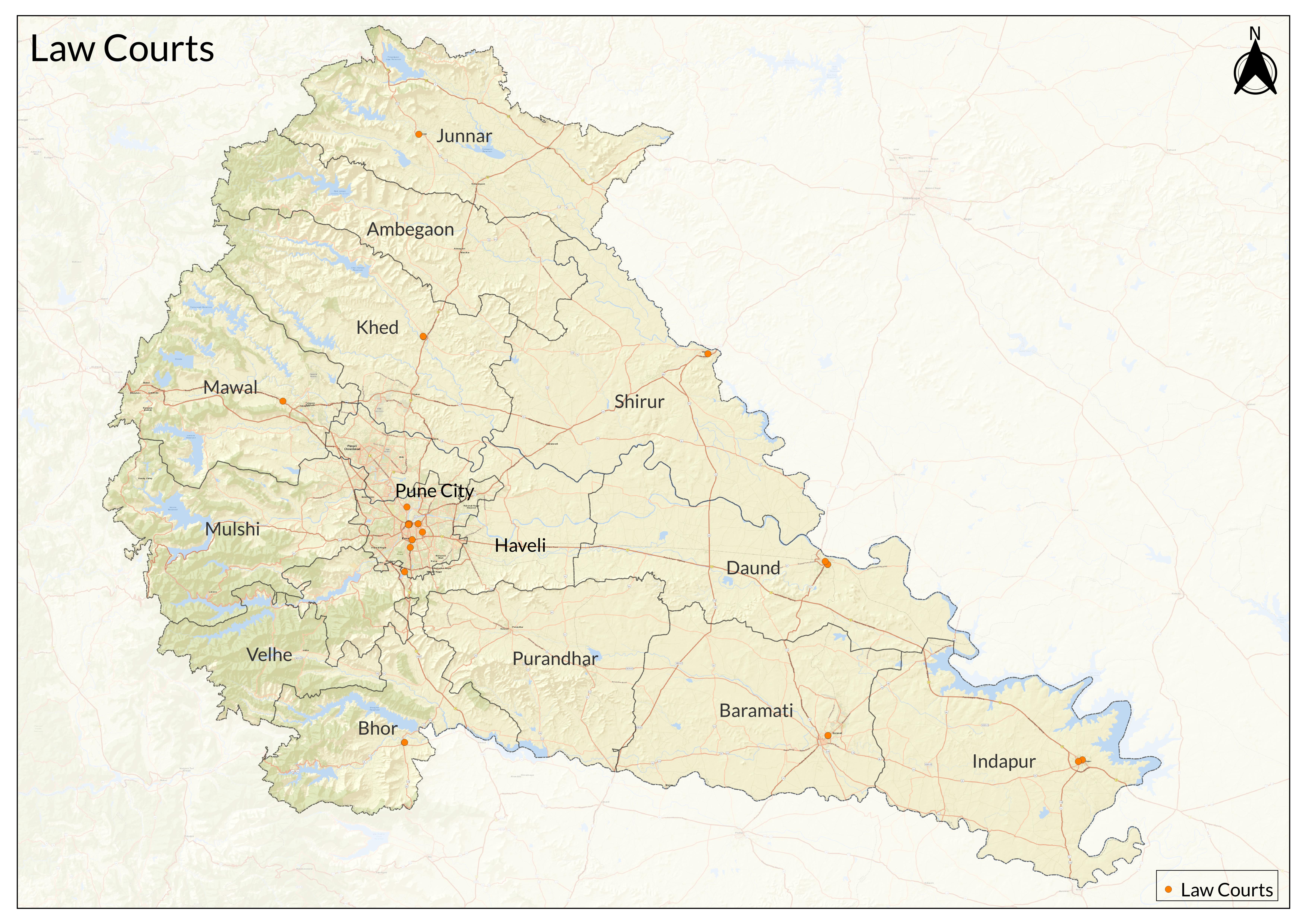Contents
- Jail System
- Community Perception of Safety
- Graphs
- Criminal Cases
- A. Cognizable Crimes under the Indian Penal Code (IPC)
- B. Select Offenses affecting the Human Body
- C. Select Offenses against Property
- D. Select Offenses against Public Tranquility
- E. Select Offenses relating to Documents and Property Marks
- F. Select Miscellaneous Crimes under the IPC
- G. Cognizable Crimes under Special and Local Laws (SLL)
- H. Select Offenses under Special and Local Laws (SLL)
- I. Crimes against Women
- J. Select Cases of Crimes against Women
- K. Cyber Crime
- L. Select Cases of Cyber Crime
- M. Cases of Fraud
- N. Reported Crimes against Women and Children
- Police Infrastructure and Workforce
- A. Police Infrastructure
- B. Police Officers and Employees
- Judicial System
- A. Number of Functioning Courts
- B. Judge Positions
- C. Cases Resolved
- D. Number of Original Cases Resolved
- E. Number of Appeal Cases Resolved
- Sources
PUNE
Police & Judiciary
Last updated on 5 November 2025. Help us improve the information on this page by clicking on suggest edits or writing to us.
The Pune Police Department is responsible for maintaining law and order across the district through a structured framework divided into multiple divisions, including Shivajinagar, Swargate, Khadki, and Hadapsar. These divisions collectively oversee 40+ police stations, ensuring efficient crime prevention, investigation, and public safety.

The Shivajinagar Division covers key areas in central Pune, including major commercial and administrative zones. The Swargate Division manages law enforcement in the southern part of the city, overseeing residential and industrial areas. The Khadki Division handles the northern part of Pune, including military and defense establishments, while the Hadapsar Division is responsible for the eastern region, which includes IT hubs and expanding residential complexes. In the city, people colloquially call the police Mama, Kaka, Saheb, Sir, and Madam or Tai for female officers.
Jail System
Pune is home to an important jail, which was a silent witness during India’s freedom struggle and the post-independence political turmoil, housing many prominent leaders, the Yerawada Jail.
![The Famous Yerwada Jail has had inmates such as including prominent freedom fighters like Mahatma Gandhi, Jawaharlal Nehru, and Subhas Chandra Bose. Other notable figures who were imprisoned there include Bal Gangadhar Tilak, Sanjay Dutt, and even the terrorist Ajmal Kasab[1]](/media/statistic/images/maharashtra/pune/police-judiciary/the-famous-yerwada-jail-has-had-inmat_FXcY9u5.jpg)
![The yard where Mahatma Gandhi was imprisoned. (B-Yard)[2]](/media/statistic/images/maharashtra/pune/police-judiciary/the-yard-where-mahatma-gandhi-was-imp_FjdOYdn.png)
![The room where Mahatma Gandhi was held.[3]](/media/statistic/images/maharashtra/pune/police-judiciary/the-room-where-mahatma-gandhi-was-hel_yiGleND.png)
![The inscription outside the room displays information about his other inmates, Sardar Vallabhbhai Patel and Mahadev Bhai Desai.[4]](/media/statistic/images/maharashtra/pune/police-judiciary/the-inscription-outside-the-room-disp_b5nlsg7.png)
Spread over 500 acres, Yerwada Central Jail is one of the largest in South Asia and the biggest in Maharashtra. It has been certified as a Grade II Heritage Site by the Pune Municipal Corporation (PMC). The construction of the Yerawada Central Jail started in 1866 and was finished in 1880 by the Public Works Department of the British administration, with its main objective to curb congestion in district prisons. The high-security cells in the complex are confined by four high walls and are divided into various sections and barracks. Besides this, there are spaces like the ‘Gandhi Yard’ and ‘Tilak Yard’ where nationalist leaders Mahatma Gandhi and Lokmanya Tilak were kept as prisoners. There is also a separate section for women and an open jail where inmates given life imprisonment are kept after they have completed a minimum of five years in the Central Jail. There is a ‘Faasi Yard’ where convicts given the death penalty are executed.
![An Old picture of the Jail[5]](/media/statistic/images/maharashtra/pune/police-judiciary/an-old-picture-of-the-jail5-fbb9c7b5.jpg)
The jail gained much public attention when Mahatma Gandhi was imprisoned here, thrice during the freedom struggle: from March 1922 to February 1924, from January 1932 to May 1933, and again in the same year in August for 22 days. It was during these years in jail that he wrote his famous autobiography ‘The Story of My Experiments with Truth.’ Additionally, he reinvented his spinning wheel or ‘charkha’ into a new foldable version here.
In 1932, Mahatma Gandhi went on an indefinite ‘fast unto death’ at Yerwada Jail, against the Communal Award proposed by the British Prime Minister Ramsay MacDonald on the 16th of August 1932, which gave separate electorate representation to the ‘depressed classes,’ now known as the Scheduled Castes (SCs). Gandhi believed that this was some evil plot by the British to divide Hindus from these classes. Dr B.R. Ambedkar, who was in favour of the proposal, eventually had to compromise, and an agreement was signed by 23 people, famously known as the ‘Poona Pact’. Madan Mohan Malaviya represented the Hindus, and Dr Ambedkar and Gandhi represented the depressed classes. The negotiation took place under a mango tree, which still exists in today’s ‘Gandhi Yard’.
Leaders such as Subash Chandra Bose, Bal Gangadhar Tilak, Pandit Jawaharlal Nehru, Sarojini Naidu, and Sardar Vallabhbhai Patel were also detained here by the British. During the Emergency in the post-independence era, political opponents like Balasaheb Deoras, Atal Bihari Vajpayee, Pramila Dandavate, and Vasant Nargolkar were also imprisoned here. Social activist Anna Hazare and Bollywood actor Sanjay Dutt were also detained in Yerawada Jail. The 26/11 attack convict Ajmal Kasab was hanged and buried here on November 21, 2012.
Today, the jail faces a severe challenge: the shortage of prison staff. Besides, a population of 7000 prisoners far exceeds the nominal capacity of 2500. The prison infrastructure has been under extreme strain. This problem of congestion and poor living conditions of inmates led to the Maharashtra State Human Rights Commission (MHRC) issuing a notice to the jail demanding better conditions for the prisoners.
On 26th January 2021, the Maharashtra Government decided to open up the Yerawada Central Jail for the public to promote ‘Jail Tourism’ within the state. Tourists can now see the Gandhi and Tilak Yards, which do not house any inmates, as well as the Faasi Yard.
Community Perception of Safety
According to locals, Pune city is generally considered safe for women and children, even during late-night hours, compared to other urban centers in India. This perception is largely attributed to the active presence of the police force. However, as is common across the country, women are often accompanied by a male companion when traveling at night. During the day, parents feel comfortable allowing their children or daughters to commute alone within the city, though they typically advise them to return home before 9 pm.
Locals also note that safety levels in Pune's urban areas are notably higher than in the surrounding villages. The city's dense residential zones and frequent public movement contribute to a greater sense of security. In contrast, rural areas, where houses are more dispersed, are perceived as relatively less safe due to their lower population density and limited police presence.
Graphs
Criminal Cases
Police Infrastructure and Workforce
Judicial System

Sources
Hindustan Times. 2019. Gandhi, Ambedkar, and the 1932 Poona Pact. Hindustan Times, India.https://www.hindustantimes.com/india-news/ga…
Sahapedia. YerawadaCentralJail. Sahapedia.https://map.sahapedia.org/article/Yerawada%2…
The Daily Guardian. 2023. Yerawada Jail Uncovered. The Daily Guardian, India.https://thedailyguardian.com/yerwada-jail-un…
The Hindu Business Line. 2012. Ajmal Kasab Hanged. The Hindu Business Line, India.https://www.thehindubusinessline.com/news/aj…
The Print. 2021. Gandhi, Sanjay Dutt, Kasab—Pune’s Yerawada Jail Open to Public, Has Many Stories to Tell. The Print,India.https://theprint.in/statedraft/gandhi-sanjay…
Last updated on 5 November 2025. Help us improve the information on this page by clicking on suggest edits or writing to us.